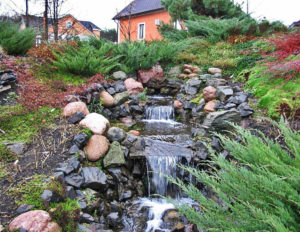
How does your lake or pond behave when it overflows after a good rain storm?The lake spreads in all directions, sometimes blocking the approaches to it. In this case, the drainage hole under the trough helps me. If there is not too much water, then the spill does not occur — everything goes into the rubble under the reservoir.
But what if the lake is arranged without a rigid shape? There are several techniques that will help you quickly divert water from the shore.
You can set up a drainage pit, a so-called absorbing well, next to your pond. The optimal size of such a pit is about one cubic meter. It should be filled with any easily permeable material. It can be brick, gravel, stone, crushed stone.
It is desirable that this pit is located below the level and at a distance of about 1 meter (1.1 yard) from the edge of the reservoir.
The pond and the pit are connected by a pipe. If the bottom of the reservoir is made of a soft material, such as a film, the pipe is simply pressed a little into the shore. Don’t worry that the pipe will ruin the view. The plants will gradually overgrow near it and close the pipe. But if the issue is significant, it can be hidden with the help of beautiful stones or rubble.
Sometimes it is difficult to lay a pipe at all. T can be done as follows: dig a small groove, cover its bottom with a film and fill it with crushed stone, gravel or small stones. And sometimes we have to divert the water quite far from the pond. At the same time, the groove itself can be disguised as a dry flow channel.
Often the pond is located in a low place of terrain. It collects a lot of water from the surrounding area. The water flowing down the ground brings a lot of dirt, soil particles and plants to the pond or lake. Such reservoirs, located in the low-lying part of the site, may eventually turn into a swamp, and their biological balance will be disturbed.
Such lakes can be protected by a device around their perimeter – a drainage ditch connected to a drainage pit for collecting water. It can be located at a small distance from the edge of the reservoir, lining the bottom and walls with geotextile and filling up with rubble
You can pour crushed stone all over the shore of the reservoir so that it covers the groove. It’s just a wide bank of gravel. To keep it from looking boring, place it on a few large rocks and boulders to plant moisture-loving plants.
The drainage ditch serves as a natural filter, and the water from it is piped into the reservoir. In this case, the water will already be cleaned and will not clog in.
In order for the water to get into the pond faster, a perforated pipe is laid in the drainage ditch. After laying the pipe, it is advisable to cover it with geotextile, and then fill the ditch with gravel. The backfill level is slightly below the ground level. Then lay a non-woven material, on top of which is poured fertile soil. This groove will be completely invisible.




Leave a Reply